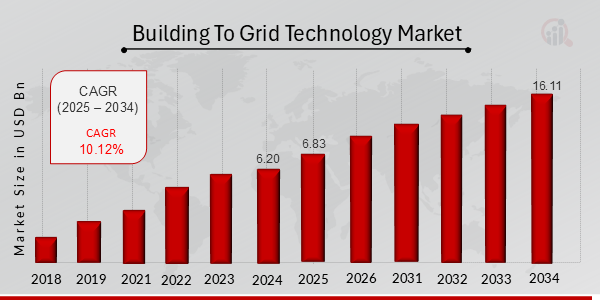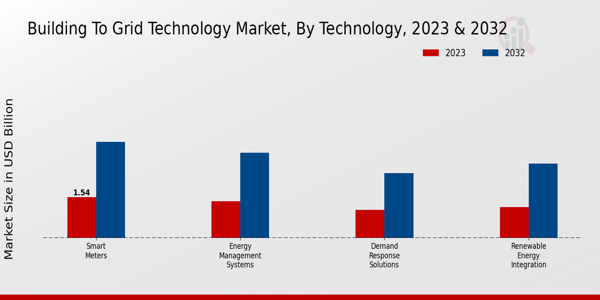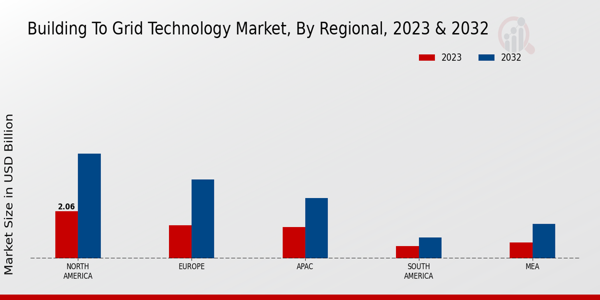Building to Grid Technology Market Overview
As per MRFR analysis, the Building To Grid Technology Market Size was estimated at 6.20 (USD Billion) in 2024. The Building To Grid Technology Market Industry is expected to grow from 6.83 (USD Billion) in 2025 to 16.11 (USD Billion) till 2034, at a CAGR (growth rate) is expected to be around 10.12% during the forecast period (2025 - 2034).
Key Building to Grid Technology Market Trends Highlighted
The Building to Grid Technology Market is driven by the increasing emphasis on energy efficiency and sustainability in urban development. As cities grow, there is a pressing need to optimize energy use, reduce waste, and integrate renewable energy sources. Building to grid technology offers solutions that allow buildings to interact more effectively with power grids, ensuring a balanced energy supply and demand. The implementation of smart grids and advancements in energy management systems further propel this market, facilitating real-time data sharing and improved energy distribution.
Opportunities lie in the integration of advanced technologies such as artificial intelligence and the Internet of Things, which can enhance energy management and reduce operational costs. As more electric vehicles are being developed, there is also a corresponding increase in the demand for their charging infrastructure. As more commercial and residential buildings install solar and other renewable energy generation, it is also necessary to devise ways of integrating the said structures with the grid. Doing so not only enhances energy self-sufficiency but also complements efforts aimed at curbing carbon emissions.
In recent times, there have been movements targeting energy storage and demand response systems, which enable buildings to modify their energy consumption according to grid demand. Another trend that has been noted is the increasing tendency for consumers to produce their own energy.
Different policies aimed at promoting green construction and renewable energy resources are now present in many countries, making the conditions for building to grid technology even more favorable. These trends and developments, taken together, speak to the likelihood of increased adoption of integrated energy approaches in which building to grid technology will have a place in the energy systems of the future.

Source: Primary Research, Secondary Research, MRFR Database and Analyst Review
Building to Grid Technology Market Drivers
Rising Demand for Energy Efficiency
The growing emphasis on energy efficiency and sustainability is a significant driver for the Building to Grid Technology Market Industry. As buildings account for a substantial portion of global energy consumption, stakeholders are increasingly prioritizing solutions that enhance energy performance. This trend is fueled by various global initiatives aimed at reducing carbon footprints and promoting green building practices. Building to grid technology provides a comprehensive approach to integrating renewable energy sources, optimizing energy usage, and improving overall building efficiency.With advancements in software and hardware solutions, buildings can now communicate with the grid, allowing for real-time data exchange on energy demand and availability. This not only helps in managing energy usage effectively but also enables buildings to generate excess energy through systems like solar panels, thus contributing to profitability and sustainability. Moreover, as governments around the world implement stricter regulations and incentives to promote energy-efficient designs, the adoption of building to grid technology is expected to surge.The convergence of smart technologies and energy management systems offers an unparalleled opportunity to significantly reduce operational costs and environmental impacts. Therefore, the growing demand for energy-efficient solutions plays a crucial role in driving market growth and shaping future prospects within the Building to Grid Technology Market Industry.
Advancements in Smart Grid Technologies
Advancements in smart grid technologies are another critical driver for the Building to Grid Technology Market Industry. The development of smarter electrical grids facilitates better integration of renewable energy sources, enhances grid reliability, and optimizes energy distribution. These technological improvements allow buildings equipped with grid-compatible systems to participate actively in energy markets, thereby offering additional incentives for building owners to adopt building to grid solutions.
Government Incentives and Regulations
Government incentives and regulations supporting renewable energy initiatives play a pivotal role in driving the Building to Grid Technology Market Industry. As policymakers worldwide increasingly commit to reducing greenhouse gas emissions and transitioning towards cleaner energy sources, various financial incentives, tax credits, and regulatory frameworks are being implemented to encourage the incorporation of building to grid technologies.These incentives not only motivate investment in energy-efficient infrastructure but also empower consumers to make environmentally responsible choices.
Building to Grid Technology Market Segment Insights:
Building to Grid Technology Market Technology Insights
The Technology segment of the Building to Grid Technology Market reflects a significant growth trajectory, with the overall market projected to reach 5.13 USD Billion in 2023 and steadily expanding to 12.1 USD Billion by 2032. The Building to Grid Technology Market revenue is driven primarily by advancements and innovations in various technology solutions that optimize energy consumption and integration into power grids. Smart Meters represent a key component in this landscape, dominating with a valuation of 1.54 USD Billion in 2023 and expected to rise to 3.63 USD Billion by 2032. Their importance lies in enabling real-time monitoring and management of energy usage, fostering efficient consumption and enhanced user engagement.Similarly, Energy Management Systems are pivotal, valued at 1.38 USD Billion in 2023 and projected to grow to 3.22 USD Billion by 2032, as they facilitate improved energy efficiency and cost savings for organizations by allowing comprehensive monitoring and control. Demand Response Solutions, valued at 1.05 USD Billion in 2023 and anticipated to increase to 2.45 USD Billion by 2032, also play an essential role in enabling users to adjust their energy consumption based on real-time demand, helping stabilize the grid during peak loads while offering financial incentives. Meanwhile, Renewable Energy Integration is gaining momentum with a valuation of 1.16 USD Billion in 2023, growing to 2.8 USD Billion by 2032. This sub-segment is noteworthy due to its focus on facilitating the incorporation of cleaner energy sources into the grid, thereby supporting sustainability initiatives and reducing dependence on fossil fuels.The Building to Grid Technology Market segmentation highlights a robust strategic enhancement in energy systems driven by increasing energy demands and the need for more sustainable practices. The significant growth across these technology categories underscores a collective push towards smarter, cleaner energy management solutions in response to global energy challenges, with opportunities for widespread adoption and development as the market evolves. The combination of smart meters, energy management systems, demand response solutions, and renewable energy integration composes a comprehensive framework aimed at transforming how energy is utilized, measured, and managed in the current and future landscapes. Overall, the Technology segment plays a crucial role in reshaping energy dynamics, facilitating a seamless transition towards grid-integrated operational frameworks.

Source: Primary Research, Secondary Research, MRFR Database and Analyst Review
Building to Grid Technology Market Component Insights
The Building to Grid Technology Market, with an expected value of 5.13 USD billion in 2023, showcases substantial opportunities across its Component sector encompassing Hardware, Software, and Services. As the industry prioritizes energy efficiency and connectivity, Hardware remains a crucial element due to its integration within building systems, enabling smooth interactions with grid infrastructure. Software solutions are becoming increasingly important as they offer sophisticated data analytics and monitoring capabilities, allowing for enhanced control over energy consumption and distribution.Services, on the other hand, play a significant role in facilitating the deployment and maintenance of Building to Grid systems, ensuring operational efficiency and reliability. As the market moves towards a projected valuation of 12.1 USD billion by 2032, the growth in this segment is driven by requirements for improved energy management and sustainability, supported by trends in smart technology and enhanced regulatory standards. The Building to Grid Technology Market data reflects a clear upward trend, with key statistics underscoring the importance of these Components in driving market growth and advancing industry capabilities.
Building to Grid Technology Market Building Type Insights
The Building to Grid Technology Market is poised for considerable growth, with expectations of reaching a valuation of 5.13 USD Billion in 2023 and rising significantly by 2032. This market includes a diverse segmentation based on Building Type, encompassing Residential, Commercial, and Industrial categories. The Residential segment plays a crucial role, as the trend towards energy efficiency and renewable energy integration in homes drives demand for advanced grid technologies. Similarly, the Commercial sector is significant due to increasing regulatory pressures and sustainability goals that push businesses to adopt smarter energy solutions.The Industrial segment also dominates the landscape, with large-scale facilities focusing on optimizing energy consumption and enhancing operational efficiencies. Overall, the Building to Grid Technology Market data showcases a robust growth trajectory, highlighting the importance of these segments in shaping the industry landscape while reflecting the growing emphasis on sustainable development practices and innovative energy management solutions across the globe. The market growth is driven by technological advancements, supportive government initiatives, and the rising need for effective energy management systems in varying types of buildings.
Building to Grid Technology Market Application Insights
The Building to Grid Technology Market is projected to reach a value of 5.13 billion USD in 2023, driven by increasing demand for efficient energy management solutions across various applications. Within this market, the applications are focused on key areas such as Energy Optimization, Peak Load Management, and Distributed Generation. Energy Optimization plays a vital role in reducing operational costs and enhancing energy efficiency, making it a core component of the overall market growth. Similarly, Peak Load Management is crucial for balancing energy supply with demand, especially during high consumption hours, which leads to reduced strain on grid infrastructure.Distributed Generation supports a decentralized energy production model, contributing significantly to sustainability by integrating renewable energy sources, thus fostering lower carbon footprints. The combination of these applications not only helps in achieving energy cost savings but also supports the transition towards smarter and more resilient energy systems. As the market continues to expand, it presents numerous opportunities for innovation and implementation, driven by evolving regulations and technological advancements.
Building to Grid Technology Market Regional Insights
The Building to Grid Technology Market is experiencing notable growth across various regions, with North America representing a significant portion, valued at 2.06 USD Billion in 2023 and expected to reach 4.58 USD Billion by 2032. This region dominates due to advanced infrastructure and a strong push towards sustainable energy solutions. Europe follows closely with a valuation of 1.45 USD Billion in 2023, progressing to 3.45 USD Billion by 2032, driven by stringent regulations on energy efficiency. In the APAC region, the market stands at 1.37 USD Billion in 2023 and is forecasted to grow to 2.63 USD Billion, highlighting the increasing adoption of smart building technologies.South America and the MEA also contribute to the market, valued at 0.54 USD Billion and 0.71 USD Billion in 2023, respectively, with growth to 0.92 USD Billion and 1.52 USD Billion expected by 2032. Both regions are catching up as they invest in energy transition initiatives. This distribution reflects distinct market dynamics where North America and Europe hold majority shares, supported by comprehensive policies supporting energy management, while APAC shows significant growth potential due to rapid urbanization and demand for efficient energy systems.

Source: Primary Research, Secondary Research, MRFR Database and Analyst Review
Building to Grid Technology Market Key Players and Competitive Insights:
The Building to Grid Technology Market has witnessed significant advancements, shaped by various players striving to enhance energy efficiency and integration within the electrical grid. This market is characterized by the collaboration between building management systems and grid technologies aimed at optimizing energy consumption while reducing costs and emissions. As urbanization increases and the demand for sustainable energy solutions rises, multiple competitors leverage innovative technologies to gain market share. The competitive landscape is infused with opportunities related to smart city developments and government initiatives promoting renewable energy, driving market participants to improve their offerings and explore strategic partnerships. As a result, the market dynamics are shaped by technological advancements, regulatory frameworks, and the growing emphasis on sustainability.Siemens has positioned itself as a formidable player in the Building to Grid Technology Market, leveraging its extensive expertise in automation and digitalization. The company's robust portfolio encompasses building management solutions that seamlessly integrate with grid technologies to facilitate efficient energy consumption and distribution. Siemens benefits from its established global presence, enabling it to cater to diverse market needs across various regions. The company's strong emphasis on innovation and R&D allows it to develop cutting-edge technologies tailored to meet evolving industry demands. Further, Siemens' proactive approach towards sustainable practices is reflected in its offerings, which are designed not only to improve operational efficiency but also to contribute to the global transition towards clean energy solutions.ABB is also a prominent contender in the Building to Grid Technology Market, recognized for its strong commitment to integrating digital technologies with energy management solutions. The company has developed a comprehensive lineup of products that enhance the interoperability between buildings and the electric grid, showcasing its capability to support energy transition initiatives. ABB's strengths lie in its advanced automation technologies and expertise in electrical infrastructure, which empowers it to deliver reliable and efficient solutions to clients. The firm’s global footprint enables it to engage with various stakeholders, from commercial buildings to industrial sectors, offering scalable solutions tailored to specific energy needs. Furthermore, ABB continues to invest in research and development, focusing on innovative solutions that strengthen its position in the competitive landscape while addressing the critical need for sustainability and energy efficiency in modern building designs.
Key Companies in the Building to Grid Technology Market Include
- Siemens
- ABB
- Rockwell Automation
- Sungrow
- Trina Solar
- Honeywell
- Goodwe
- Emerson Electric
- Mitsubishi Electric
- Schneider Electric
- General Electric
- Eaton
- Enphase Energy
- Cisco Systems
- Toshiba
Building to Grid Technology Market Industry Developments
Recent developments in the Building to Grid Technology Market have been robust, with rising investments in smart grid solutions and energy efficiency driving significant growth. Companies like Siemens, ABB, and Schneider Electric have been at the forefront, unveiling innovative technologies to enhance grid integration and optimize energy consumption across buildings. Furthermore, mergers and acquisitions are shaping the competitive landscape; for instance, Schneider Electric's recent acquisition expands its capabilities in energy management solutions. Meanwhile, Honeywell and Emerson Electric are also pursuing strategic partnerships to strengthen their positions in this evolving market. In terms of market valuation, companies such as Rockwell Automation and Trina Solar have reported increases in their market shares as the global shift towards renewable energy sources prompts increased demand for building-to-grid technologies. Additionally, the growing focus on sustainability and regulatory initiatives fostering energy-efficient infrastructure contribute to a positive outlook for market players like Eaton and General Electric. The ongoing advancements in digitalization and IoT further enhance operational efficiency and energy management, aligning with the global transition towards smarter and greener technologies.
Building to Grid Technology Market Segmentation Insights
Building to Grid Technology Market Technology Outlook
- Smart Meters
- Energy Management Systems
- Demand Response Solutions
- Renewable Energy Integration
Building to Grid Technology Market Component Outlook
- Hardware
- Software
- Services
Building to Grid Technology Market Building Type Outlook
- Residential
- Commercial
- Industrial
Building to Grid Technology Market Application Outlook
- Energy Optimization
- Peak Load Management
- Distributed Generation
Building to Grid Technology Market Regional Outlook
- North America
- Europe
- South America
- Asia Pacific
- Middle East and Africa
| Report Attribute/Metric |
Details |
|
Market Size 2024
|
6.20 (USD Billion)
|
|
Market Size 2025
|
6.83 (USD Billion)
|
|
Market Size 2034
|
16.11 (USD Billion)
|
|
Compound Annual Growth Rate (CAGR)
|
10.12% (2025 - 2034)
|
|
Report Coverage
|
Revenue Forecast, Competitive Landscape, Growth Factors, and Trends
|
|
Base Year
|
2024
|
|
Market Forecast Period
|
2025 - 2034
|
|
Historical Data
|
2019 - 2023
|
| Market Forecast Units |
USD Billion |
| Key Companies Profiled |
Siemens, ABB, Rockwell Automation, Sungrow, Trina Solar, Honeywell, Goodwe, Emerson Electric, Mitsubishi Electric, Schneider Electric, General Electric, Eaton, Enphase Energy, Cisco Systems, Toshiba |
| Segments Covered |
Technology, Component, Building Type, Application, Regional |
| Key Market Opportunities |
Growing renewable energy adoption, Government incentives for smart grids, Increasing energy efficiency regulations, Technological advancements in automation, Rising demand for energy storage solutions |
| Key Market Dynamics |
Increased renewable energy integration, Rising building energy efficiency standards, Growth in smart grid technologies, Government incentives for sustainability, Advancements in energy management systems |
| Countries Covered |
North America, Europe, APAC, South America, MEA |
Frequently Asked Questions (FAQ) :
In 2024, the Building to Grid Technology Market will be valued at 6.20 USD Billion.
By 2034, the market is expected to reach a valuation of 16.11 USD Billion.
The market is expected to witness a CAGR of 10.01% between 2025 to 2034.
North America holds the largest market share, valued at 2.06 USD Billion in 2023.
The Energy Management Systems segment is projected to be valued at 3.22 USD Billion by 2032.
Major players include Siemens, ABB, Rockwell Automation, and Schneider Electric, among others.
The Demand Response Solutions segment is expected to be valued at 2.45 USD Billion in 2032.
Renewable Energy Integration is projected to reach a market value of 2.8 USD Billion by 2032.
The APAC region is expected to be valued at 2.63 USD Billion by 2032.
South America is anticipated to grow to a market size of 0.92 USD Billion by 2032.

















